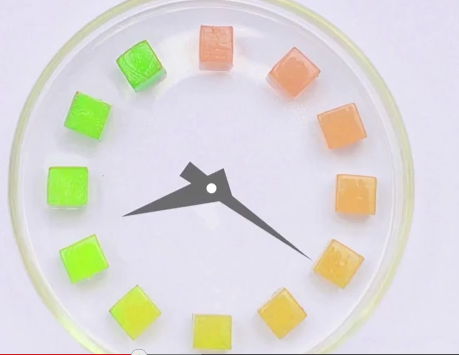Chinese scientists have created "smart tags"-- gel-like tabs that could be placed on food packaging -- that change color when the contents go bad.
Each tab is about the size of a corn kernel and is safe to use, according to creators. The tags were presented on March 17 at the American Chemical Society's National Meeting in Dallas, Texas.
In addition to placement in unopened food containers to check for spoilage, the tags can be customized to work with cans and medicine bottles. They were successfully tested with milk, with the milk exposed to a variety of temperatures and the E. coli bacteria until it went sour.
"We successfully synchronized, at multiple temperatures, the chemical evolution process in the smart tag with microbial growth processes in the milk," lead researcher Dr. Zhang Chao, a scientist at Peking University in Beijing, said in a statement.
Improperly-stored products and those that sit on store shelves for far too long often require opening to tell if spoilage has occurred. The tags will potentially eliminate the need for opening and smelling goods, as Zhang notes "the tag still gives a reliable indication of the quality of the product."
Tags are comprised of tiny, inexpensive compounds called nanorods, which are made from gold and silver and cost one-fifth of a penny each. The tags also feature vitamin C, acetic and lactic acids and agar, all of which react with nanorods to change tag color. When a food is "100% fresh," tags are red or reddish orange. As the product ages, the tags change to orange, yellow and finally green, with the latter indicating food is completely spoiled. Gold nanorods are naturally red, however interaction with the silver nanorods over time causes the color change. The process is designed to mimic food deterioration based on expiration date, as well as spoilage due to temperature changes.
"Therefore, as the silver layer thickens over time, the tag color evolves from the initial red to orange, yellow, and green and even blue and violet," the scientist explained.

The tags are programmed to change colors over the expiration cycle of a product, but can also react to temperatures.
Other projects in the past have tried to tackle the issue of easily identifying food that's past its prime: UWI Technology was working on a color-coded labeling system with strips in 2011, while scientists in Glasgow were also looking at tacking the problem with packaging made of 'intelligent plastics' that would serve as an indicator of freshness.
Dr. Zhang Chao's preliminary research was published in the journal ACS Nano in April 2013.
Reported by: Ryan Jaslow
Source: CBS News
Edited by: Arthars